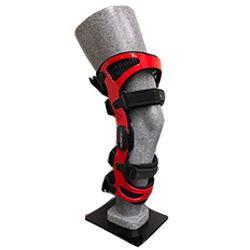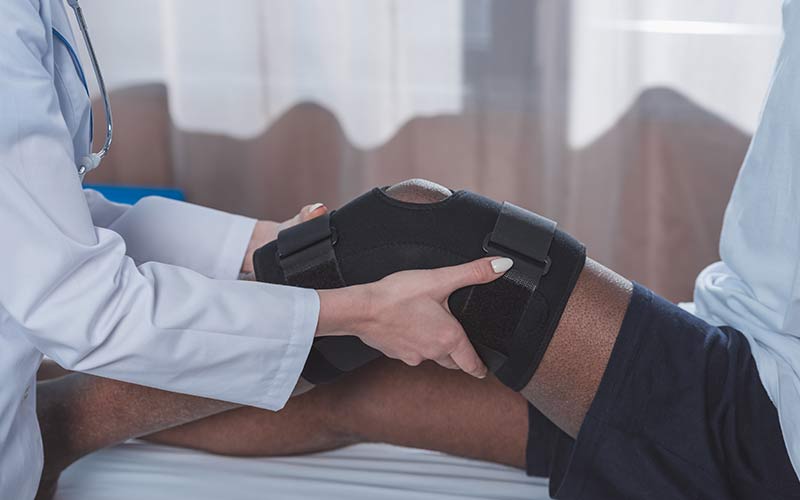Knee Braces. They have been used for decades. From the weekend warrior to the elite level athlete, and everything in between, they have been a way to help individuals optimize their function and perform their activities of daily living with less pain.
So how do they help? Firstly, it is important to understand the following:
- There are many different types of knee braces, each of which can help in their own individual way.
- One size most definitely does not fit all, and each brace should be adapted to meet the specific needs of the individual.
- A thorough assessment from your Panther Physiotherapy provider can assess your candidacy for a brace.
- It is meant to be an adjunct to your therapy to help you reach your goals, not a fix.
Below we can break down some of the commonly used purposes for bracing.
- Addressing Impairments - The brace can help aid in unbalanced forces through the knee joint (osteoarthritis), promote and maintain optimal alignment during early phases of tissue healing (ligament strains/sprains), or aid with unbalanced muscle forces (patellofemoral pain syndrome, or mal-tracking of the knee cap on the knee joint).
- Enhance Function - Your brace may aid with providing stability to improve control of the knee joint. Strengthening and hypertrophy (growth) of muscles can often take upwards to 8-12 weeks, and the brace may provide the stability needed while this training takes place. It may also have a learning/coordination (proprioception) effect
on your muscles. - Participation - It may also help with participation at home, school, work, sport, and allow an individual the added support they need for a quicker return to play, or aid in the
prevention of an injury should they be deemed at a higher risk. Again, it should be noted that these are meant to address the specific needs of the individual.
What are the different types of braces?
There are many. Here are some of the most commonly prescribed braces:
1. Patellar PTO
Patellar (knee cap) mal-tracking is a common problem for both young/older individuals alike. The reason for this mal-tracking could be something locally at the knee, or the problem could be driven from above (hip joint, spine) or below (ankle/foot), leading to knee discomfort. Regardless of the reason, the patellar PTO brace aids the knee cap in staying within its normal pathway or track on the groove it sits on, to allow you more comfort while you work with your Panther Physiotherapist to address the restrictions leading to your issue.
2. ACL Brace
In the past, it was common practice for almost every post-surgical ACL Reconstruction to be fitted for a custom ACL brace. Times have changed, and the surgeons' recommendations for the brace is variable, or sometimes, not at all.

As with the other categories of bracing, it will depend on your presentation, including age, sport, adherence to your muscular program and date of your return to sport/activity. Panther Physiotherapy fits you for the Bregg Fusion Brace, which was created for a comfortable, precise fit that won’t compromise your mobility. It is available custom and prefabricated with a frame colour of your choice.
3. OA Offloading Brace
In clients with knee OA and a mild varus/valgus instability (inner/outer knee instability), a knee brace can aid in reducing pain, improving stability and diminish the
Other recommendations from our therapists may
- Education,
- Regular aerobic exercise,
- strength training,
- Nutrition/weight management,
- Consulted footwear,
- Physiotherapy (modality use, acupuncture, IMS, exercise prescription, education, manual therapy).
Panther Physiotherapy fits for the Bregg Fusion OA Offloading Brace. This brace provides patients with either medial or lateral compartment (inner/outer knee) off-loading for unicompartmental (1 area of the knee) osteoarthritis. It has Bregg’s exclusive adjustable hinge
4. Hinged Knee Brace
The hinged knee brace can be utilized for a number of reasons but is most commonly prescribed by your Panther Physiotherapists for mild medial/lateral instabilities (inner/outer) of the knee joint. It features hinges on the inside/outside of the brace and can be used for MCL/LCL injuries, and mild ACL/PCL injuries which are all important ligaments in keeping your knee stable. The therapist needs just perform 2-3 measurements of the circumference of your knee and the brace is available in the clinic.
Stay Mobile,
Travis Gaudet MScPT., BScKin., cGIMS., CFST-1., CAFCI
References:





